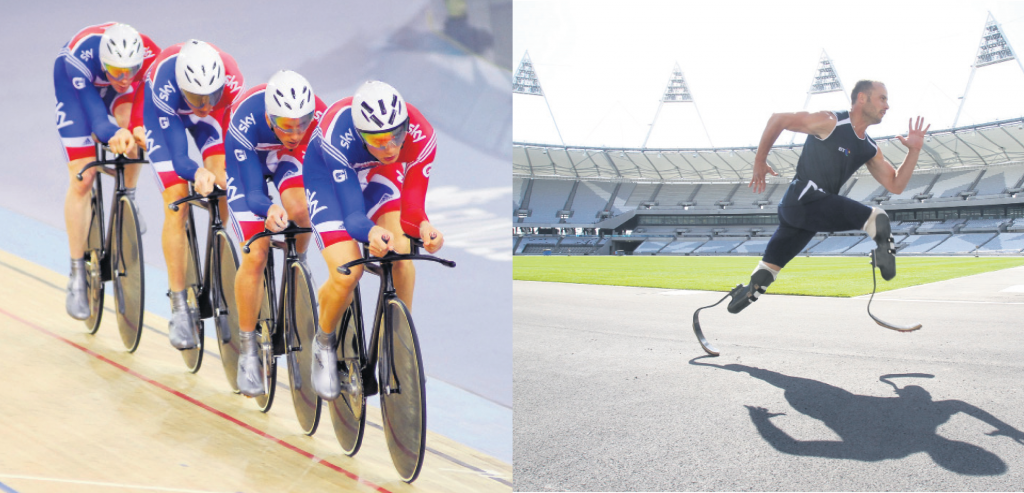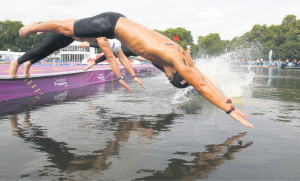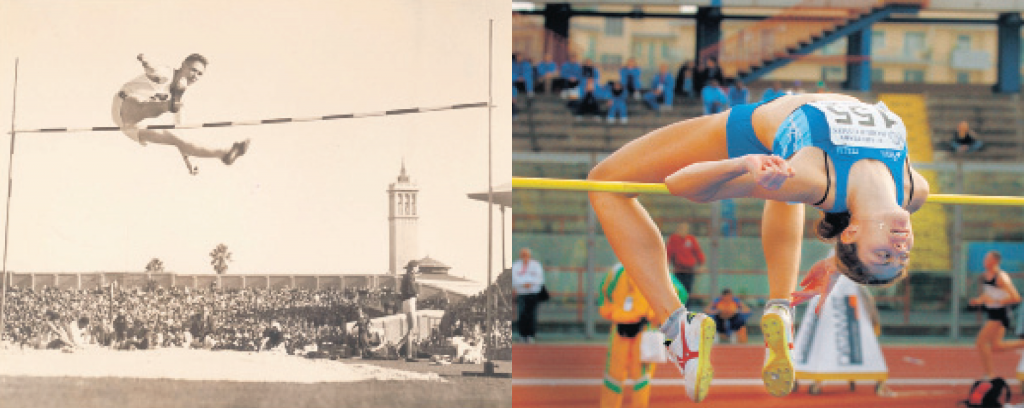FRIDAY, 27 APRIL 2012
The revival of the Olympic Games in 1896 marked a new era for modern sports, with hundreds of athletes coming together to compete in Athens. One hundred and sixteen years later, the games have evolved, with thousands of athletes representing hundreds of nations. Each Olympics marks the setting of new sporting records—at the Beijing Olympics alone 132 records were broken. With the passing of time, Olympians are becoming higher, faster, stronger.Scientific progress plays a major role in the ongoing advancement of our sporting heroes; whether it is in designing better materials, understanding how best to achieve optimum performance both physically and mentally, or applying physics to determine the ‘perfect’ technique, science is behind the scenes, driving improvement.
Sports equipment, for example, has seen tremendous development since the modern Olympics began—once influenced purely by safety and comfort, an athlete’s equipment can make the difference between winning and losing. Cycling helmets are a key example of how an item, implemented as a result of safety concerns, can enhance performance. The improved aerodynamic profile obtained by wearing a helmet can enable cyclists to complete time trials seconds faster. Similarly, while running shoes featuring air-cushioned, shock-absorbent soles are designed with comfort and injury-prevention in mind, athletes who wear them can take advantage of increased bounce and lengthened stride. These advances are made possible by breakthroughs in science and the use of modern materials, such as plastics and composites.
Polyurethane is one such material—a polymer consisting of a chain of repeating units called carbamates. These carbamates are judiciously selected to allow the flexibility, firmness and density of the resulting polyurethane to be tailored specifically for its use. Seventy-five years ago, this versatile material was discovered in a German laboratory; now, it is revolutionising contemporary sportswear. Polyurethane was used in the design of swimsuits where, in conjunction with other materials, it was an asset to an athlete in a number of ways. A flexible polyurethane foam contained microscopic pockets of air, which increased buoyancy, while the water-repellent surface reduced the drag experienced by the swimmer. Not only did the polyurethane material aid the swimmer, but the style in which it was shaped was also critical. Suits were designed to compress the body and make the swimmer more hydrodynamic. However, the improvements in buoyancy and hydrodynamics offered by these swimsuits were so effective that they distorted races and have been banned since 2010.
Polymer materials like polyurethane can be enhanced further by reinforcement with filaments of carbon. These filaments are created from a polyacrylonitrile polymer—made up of carbon and nitrogen atoms—which is heated in air to create a stable hexagonal structure, and finally heated at over 1000 degrees Celsius in order to expel all non-carbon atoms. This process results in crystalline carbon fibres of approximately 5 micrometres across. These fibres can be woven into a flexible fabric ready for incorporation with a polymer. Carbon-fibre-reinforced polymers (CFRP) are lightweight yet strong and durable, and have found use in many areas including aerospace engineering and medical devices.
The late 1980s heralded the arrival of sports prostheses constructed from flexible carbon-fibre, which have since transformed the Paralympics. The flexibility of CFRP makes it an excellent material for lower limb sports prostheses, in which propulsion and impact-minimisation are critical. On each downward step, the body weight of the athlete compresses the curved carbon-fibre shank of the prosthesis and that energy is stored within the material. When the body weight transfers off the prosthesis, its original shape is restored and this energy is returned, propelling the athlete forward. CFRP is also used in a variety of sporting equipment, including golf clubs, bicycle frames and tennis racquets, which benefit from its lightweight and durable properties.
The evolution of sports materials is fuelled by scientific discovery; these materials are enabling athletes to optimise their ability and improve their performance. Nevertheless, at the end of the day it is still the athletes’ bodies that have to push them forward. However easy these Olympians make their athletic feats seem, their achievements actually represent one of the most strenuous challenges to the body’s homeostasis: exercise. With an understanding of the basic science behind the exercise of any given sport, coaches can optimise the training and dietary regimes of Olympians under their care.
The common denominator of all events in the Olympic games—from stretching the bow in archery to leaping across a balance beam in gymnastics—is the need for energy in the form of adenosine triphosphate (ATP). Muscle fibres are primed with ready-to-use ATP, which can be replenished by a compound called phosphocreatine. However, the combination of phosphocreatine and muscle ATP is enough for merely 15 seconds of intense exercise. For longer intervals, muscle fibres must scavenge ATP from elsewhere.
The liver and fat tissue are the reserves for the body’s next sources of energy: carbohydrates and fat. How much energy comes from each source depends on the intensity of exercise. While the body is able to supply sufficient oxygen, aerobic metabolism churns energy out of glucose and fatty acids. This type of metabolism is common in endurance sports, like running, cycling and swimming, where slow-twitch muscles are most utilised.
Typically, the threshold for aerobic metabolism is passed once athletes exceed 70 per cent of their maximal exercise capacity. At that point, the body shifts to anaerobic metabolism in the fast-twitch muscles, which cannot use fat as fuel. Because anaerobic metabolism produces ATP 2.5 times faster than aerobic metabolism, it comes into play whilst training for high-intensity sports, like weightlifting.
By knowing what kind of metabolism a particular sport elicits, Olympians can consume a diet rich in the nutrients they most need. In other words, there is a reason behind the Olympic diets that are notoriously high in calories. For example, Michael Phelps reportedly consumed 12,000 calories a day during the 2008 Olympics.
In 1980, Dave Costill at Ball State University in Indiana showed that endurance athletes benefit from increasing the carbohydrate portion of calorie intake from 50 to 70 per cent during the three days preceding a big race. Though often disputed, this notion of ‘carbohydrate loading’ has remained a popular practice. In 1987, John Ivy at the University of Texas showed that there is a two-hour window following strenuous exercise when muscle fibres actively withdraw carbohydrates from the bloodstream for future use. Athletes are encouraged to stockpile on carbohydrates during this short interval in order to build up energy reserves in their muscles.
Although multiple factors affect exercise tolerance, the maximum volume of oxygen athletes can carry best predicts whether or not they can reach Olympic status. Clinically, this volume is measured as VO2max. This needs to be able to match the increased blood flow athletes experience during exercise, when the volume of blood pumped by their hearts goes up 6 to 8-fold. Initially, this change in cardiac output is due to an increased heart rate, but activation of the sympathetic nervous system allows the heart to squeeze out more blood per stroke and leads to slightly elevated blood pressure. Interestingly, the distribution of blood flow also changes. At rest, 21 per cent of cardiac output goes to muscle, but during heavy exercise this increases to 88 per cent, having been diverted from major organs like the gastrointestinal tract, kidneys, and skin.
Priming your body for competing is clearly important, but what about your mind? Knowing how to ski jump is one thing, but jumping at a national competition requires a lot more resilience. One has to have the mental strength to withstand the pressure of competing, risk of physical injury and demand to perform in front of a big and expecting audience. Nowadays, professional athletes will often have not only a sports coach but also a dedicated sports psychologist to help them achieve the right mental state during training and competing.
Confidence, ability to keep composure under stress, and internal motivation are just three of the personality traits that help achieve success in sport. Individuals who posses these traits make excellent athletes, but the question is: are these innate qualities or can they be acquired?
Self-confidence can be encouraged using goal setting. As long as the targets are specific, measurable and difficult, but still attainable, achieving them should create a feeling of ability and empowerment. For example, in archery, competitors can set their goals at a particular score and then increase that by 10 or more points from one competition to the next, so even without winning they can feel a sense of accomplishment. Sportsmen and women are also advised to perform the same routine during training and competition to help them control their nerves and maintain composure. For example, runners will have a set warm up, and repeating that before a major competition can put them in the mindset they had when training in private.
With a calm mind and enough training, athletes can use techniques to relax and control their physiology, including slowing down their heartbeat, by sheer will power. This has been claimed to be particularly useful for aiming true in shooting sports, although science is at a loss to explain the exact process.
Another widely used technique is imagery, for example where an athlete will imagine the run up, the precise movement of a jump and the landing. Research has shown that thinking about a physical action helps strengthen the connections between neurons in the brain, making its eventual execution much better.
Psychological resilience can also be used in a more offensive way: intimidation of competitors. While this is seen as a normal part of some sports, such as professional boxing, it can be problem in others. This has been particularly pronounced in running, where certain competitors would cause repeated false starts in order to put off their opponents. In 2010 the International Association of Athletics Federations introduced a zero-tolerance policy, which means that regardless of circumstances any false start results in disqualification. The rule has come under scrutiny and became particularly controversial when multiple Olympic gold medallist Usain Bolt was disqualified during the 100 metres final at the World Championships in Daegu last year. It has been suggested that the rule should be changed to allow each athlete at least one mistake during an event, to account for a simple human error caused by excessive pressure.
It is clear that the mind is just as important as the body in order to excel and push the limits of human performance. Often the key to unlocking physical capacity is in the mind, and sport psychologists are working hard to find and use this key.
So, you have eaten all the right things, visualised yourself winning and bought state-of-the-art equipment—now what do you do? Natural ability or raw power are useless without proper technique, and in the high jump technique is everything.
The high jump was originally attempted from a standing start and the introduction of a run-up to the event led to widespread use of the ‘scissors technique’. Jumpers would drive the inside leg up and over the bar, forcing it downwards on the other side to help lift the trailing leg over—producing a movement of the legs like the blades on a pair of scissors. This technique is actually rather inefficient, but to understand why we must look at some of the physics behind an athlete’s jump.
Modelling the athlete as a projectile making an arc over the bar shows that the height of the peak is proportional to the initial upwards velocity squared. This height represents the position of the athlete’s centre of mass—the single point at which the distribution of mass in every direction is balanced. For something like a snooker ball, this is fixed at the dimensional centre. For a moving, pulsating object like a person things are not so simple—as you contort your body by moving your arms, legs and neck, the position of your centre of mass changes.
During a scissors-jump the body is upright, and its centre of mass is at a point considerably above the bar—around 30 centimetres. Lying back while airborne brings the centre of mass closer to the bar, so less energy is needed to lift the body and the jump is more efficient. This technique, the ‘Eastern cut-off’, was used by Michael Sweeney in 1895 to set a new world record of 1.97 metres.
High jumpers began refining their technique by flattening out their bodies and lowering the height of their centre of mass. The ‘straddle jump’ is a very elaborate procedure where take-off is made from the inside leg. The outer leg leads the movement and swings over the bar. The athlete jumps with their chest, rather than their back, facing the bar throughout as they roll over it. The straddle dominated for about 40 years, with Soviet Valeriy Brumel using it to raise the bar to 2.28 metres in the 1964 Olympics.
It was four years later, however, that the technique now used across the world gained international attention. American athlete Dick Fosbury developed a technique that put the soft landing mattresses to good use. The ‘Fosbury flop’ enables athletes to jump over the bar while their centre of mass is actually underneath it, making optimal use of the energy used to explode into takeoff. Whilst previous techniques required the whole body to clear the bar at about the same time, modern high jumpers curl themselves over the top of the bar, with the majority of their body being below it at any one moment. The head, torso, hips and legs clear the bar in succession and jumpers finish on their backs—something which was not possible when athletes were required to land on sand.
Cuban Javier Sotomayer used the flop in 1993 to jump 2.45 metres—the current world record. Few other athletic events have exhibited such a significant change in technique over their history, allowing athletes to set new records and reach new heights.
In the stadium, at the laboratory bench and along the vast distance between, science is enabling athletes to achieve their Olympic dreams.
Ability and confidence are optimised through preparation made possible by an enhanced understanding of physiology and psychology. Performance comes that bit closer to perfection when the mechanics of sport are modelled and analysed, while modern advances in sports materials augment the ability of the athlete beyond that which was dreamt possible when the Olympic Games were revived over a hundred years ago. In these and numerous other ways, it is possible to see the rewards of scientific achievement reflected in the triumph of our Olympians.
This summer sees London host the Olympic Games for the third time, giving us the opportunity to witness sporting history first-hand and to celebrate some of the science that makes it all possible.
Ruth E Gilligan is a 4th year PhD student in the Department of Chemistry
Leila Haghighat is an MPhil student in the Department of Medicine
Maja Choma is a 3rd year PhD student at the Cambridge Institute for Medical Research
Anand Jagatia is a 3rd year undergraduate in the Department of Neuroscience







